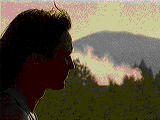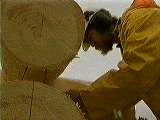

![]()

|
A Cut Above: My Grandfather Was a Logger.
Directed by Karen Bastgailis.
Grades 9 and up / Ages 14 and up.
***/4
|
excerpt:
"Switzerland outlawed clearcutting two hundred and eight years ago. When I was there in 'eighty-six, their cut was one-tenth of our cut in British Columbia. You had that one-tenth employing ten times the number of people and getting eleven dollars into their economy for every buck we got . . . We just don't make sense."
 A Cut Above is a look at the logging industry on Vancouver
Island and the West Coast through the eyes of Mike Tardiff, a
third-generation worker in the forest-industry.
A Cut Above is a look at the logging industry on Vancouver
Island and the West Coast through the eyes of Mike Tardiff, a
third-generation worker in the forest-industry.

Highly recommended for senior classes in environmental studies or current affairs.
T.S. Causabon is a freelance writer living in Winnipeg.
To comment on this title or this review, send mail to cmeditor@mts.net.
![]()
Copyright © 1996 the Manitoba Library Association.
Reproduction for personal use is permitted only if this copyright notice
is maintained. Any other reproduction is prohibited without permission.
Published by
The Manitoba Library Association
ISSN 1201-9364
![]()